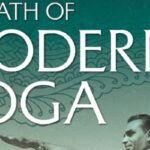
Elliott Goldberg Rides the Elephant: An In-Depth Review of The Path of Modern Yoga
August 4, 2016
Guru or Guide: What’s the Scope of Practice? A Second Response to Christopher Wallis
August 10, 2016For the master’s tools will never dismantle the master’s house. They may allow us to temporarily beat him at his own game, but they will never enable us to bring about genuine change.– Audre Lorde
Christopher Wallis asked me to respond to his eloquent piece on gurus-gone-bad, and how to stay away from them. I’m happy to do just that with this short post.
(Positional statement: I’m writing here as a non-Indian yoga practitioner who has interacted with echoes of the Indian guru-shishya system that have been borrowed, adapted, appropriated, or manipulated during the globalization phase of yoga.)
Wallis starts out with a much-needed, apology-free censure of abusers, asserting that “no excuses can be made for any teacher who ignores the principle of consent.”
He then interrogates some of the stripped-down claims of Hatha literature that suggest the technologies of practice are sufficient in themselves for waking people up to goodness. True to his training and commitments, he uses a Tantrik view to do this, arguing that practice cannot promise virtue without the correct philosophical backing. He then makes some nice connections between Tantrik “god-realm” delusions and aspirational capitalism, revealing a dark feedback loop: we can be rewarded with power from the act of wanting power, whereas in an ideal yogaland, we’re rewarded with insight if we empower others.
His advice for the student who wants to avoid sociopaths sounds common-sensical. Look for everyday kindness and groundedness in the teacher. Try to assess the motivations of the teacher. See if those motivations are pure.
My main problem with this argument is that its rape-culture-aware understanding of consent (good) obscures a basic power imbalance in the economy of spiritual transformation (confusing). Here’s the thing: by definition, teaching spiritual transformation affords little room for consent, according to any contemporary usage of the term. This is because the fundamental agency of the person to be transformed – variously described as the small self, limiting ego function, dreaming self, etc. – is exactly what the process says it is bypassing, changing, waking up, or even annihilating. There is no more consent in the spiritual teacher-student relationship rooted in the transformational model – even if it’s benevolent – than there is in the parent-child relationship. (Which brings up the old question of the extent to which spiritual pursuits, for good or ill, are repetition compulsions that explore our formative powerlessness.)
To be fair, Wallis’ Tantrik view has a subtle take on transformation, which does as much as it can to deflate the inadequacy narrative of spiritual seeking, by which a person works to birth a better self out of the wreckage of a worse self. According to the Shaivism of Wallis’ training (if he’ll forgive me for being a little simplistic here) there is no better self to gain, but rather an essential, always-already there awareness to realize and then integrate. We don’t transform; we awaken to what we already are.
That’s all fine on the level of content. But abuse in spiritual pedagogy happens materially on the level of form and interpersonal power. It involves who has the keys, who reads the texts, who’s got the initials after their name, who knows the commentaries, who got to sit at the guru’s feet and for how long, who holds the transmission. (Beyond this lies the shadier questions about who we put in the front of the room according to the idols we need to worship or smash.) Whether the student is annihilating the small self or waking up to the already-present ground of awareness, the pedagogies of yoga have always invoked a hierarchy of knowledge and experience. The practice is said to have literal power felt to be held in literal hands that can bestow it upon you, always in a downwards direction.
I’m not saying this power dynamic can’t work for some people some of the time, any more than I’d say that being a child is somehow a negative thing in itself. But if the transformation relationship is felt to work, it will probably be because it treats a wound other than that of inequality. If it treats inequality, it will be because it’s conscious of the inequality it enacts. Appealing to notions of consent without rigorously evaluating how inequality renders consent problematic means we’re only pretending to talk about consent, because we’re leaving power out of the equation. (Power and inequality emerge through intersectional differences of age, gender, race, educational status, institutional position, neurotypical privilege, etc.)
Recent history makes this more than a semantic complaint. Relationships of spiritual mentorship – which are parent/child in nature to the extent that the aspirant, like the child, does not know the world into which they are being initiated – are slowly giving way to therapeutic relationships of attunement and intersubjective modelling, in which consent is ongoing, can be withdrawn, and most importantly, informed. Informed consent means that two equal subjects who are aware that they impact each other discuss the framework and limits of the work to be undertaken together and the purpose for it, along with its desired outcomes, safety mechanisms, and external controls (regulations, peer review, ombudspeople, etc.). This is completely foreign to most spiritual models, which generally hold that the process and content of transformation cannot be known by the aspirant, because if it could, there’d be no need for practice and effort and surrender. Ain’t no such thing as informed consent in the temple, or the meditation burrow, or around Mount Kailash, or in the zendo, or when hanging around Muktananda. Consent doesn’t emerge from religion but from therapeutics. It’s as new to spirituality as it is to patriarchal capitalism.
So without any meta-analysis of the structural power dynamics shared by abuse situations and the principle of transformation via a guru-student relationship, I find Wallis’ post a bit of a backdoor apology for systems woefully vulnerable to abuse, and I don’t think it will help people who are caught up in cults or manipulated by power addicts. I’m not saying that he doesn’t see and address power in pedagogy here and elsewhere, but he’s not talking about its role as being foundational to abuse — regardless of whether it feels beneficent or accords with an approved view.
Wallis’ implication is that a tradition can be self-correcting if somehow everyone just had better education within it. Unfortunately, this isolates power in a single loop, while weighting responsibility towards the student within that loop. In more than a decade of watching people extract themselves from abusive yoga/meditation environments and then metabolize their experiences, I can’t think of a single person who managed it solely by learning higher or more accurate or nuanced teachings from the same alleged system within which they were caught. (I say “alleged” because a key feature of harmful groups is that their systems are self-generated and self-supporting, and always have less to do with spiritual content than brokering social power.)
What seems to help a lot of yoga people discern their way out of abusive yoga communities is to get the feckin feck away from other yoga people and yoga ideas, at least for a while. Often they benefit most directly from swimming against the yoga stream: exchanging self-inquiry and self-correction for interpersonal work or feminist studies that target both the psychology and materiality of the patriarchal wound.
The chips can fall in many different ways. If they were postural yoga devotees, they might seek out Contact Improv and Axis Syllabus. If they were devoted to Tantric Buddhism, they go back to school for social work. If they were in top-down authoritarian communities, they take a new interest in things like local democracy, they study up on Robert’s Rules for how to facilitate tense meetings. Through various externalization and pro-social gestures, they allow themselves to ask what exactly it was they were yearning for after all, why they thought other people know more or are better than them, and, most importantly, why they thought that inner work alone was was going to protect them and heal everything. Inner work, after all, is as easy to exploit by the charismatic teacher as outer work is exploited by capitalism.
Many report they feel they’ve progressed when they can sense their slightly sore original face emerge from beneath the forced yoga smile.
From what I’ve seen, believing that there is a beneficent yoga-learning hierarchy somewhere out there — a place where grounded and generous beings offer the keys to transformation with no ulterior motives — doesn’t generally lead people to evaluate the basic wounds of inadequacy, abandonment, or trauma that helped draw them to a cult to begin with. Finding a better Dad may not teach you how to abandon the positions of childhood.
I want to repeat that I’m not saying beneficent pre-modern-style teacher-student relationships aren’t possible (even if today they must be infected by a degree of postmodern irony, but that’s another story) or that spiritual communities rooted in transformation narratives are inherently abusive, or that meaningful, enthusiastic, informed consent is always possible in instruction – and certainly not in parenting, despite best intentions.
I’m saying that getting away from toxic gurus by choosing better gurus supposes that a change in content can address what might be a problem of form. It supposes that the toxic guru really was interested in spirituality and not just power, but that they got it all wrong. But if they weren’t interested in spirituality at all, perhaps the wounds they inflict can’t be dressed by spirituality.
For the abuse victim, it may matter less that the new guru is grounded and that his content feels liberating, than the possibility of living for a moment in world shorn of the magic to which only a few have access, where people learn and heal by acknowledging how equally lost they are together, and where nobody believes that they have an answer any more complicated than listening.